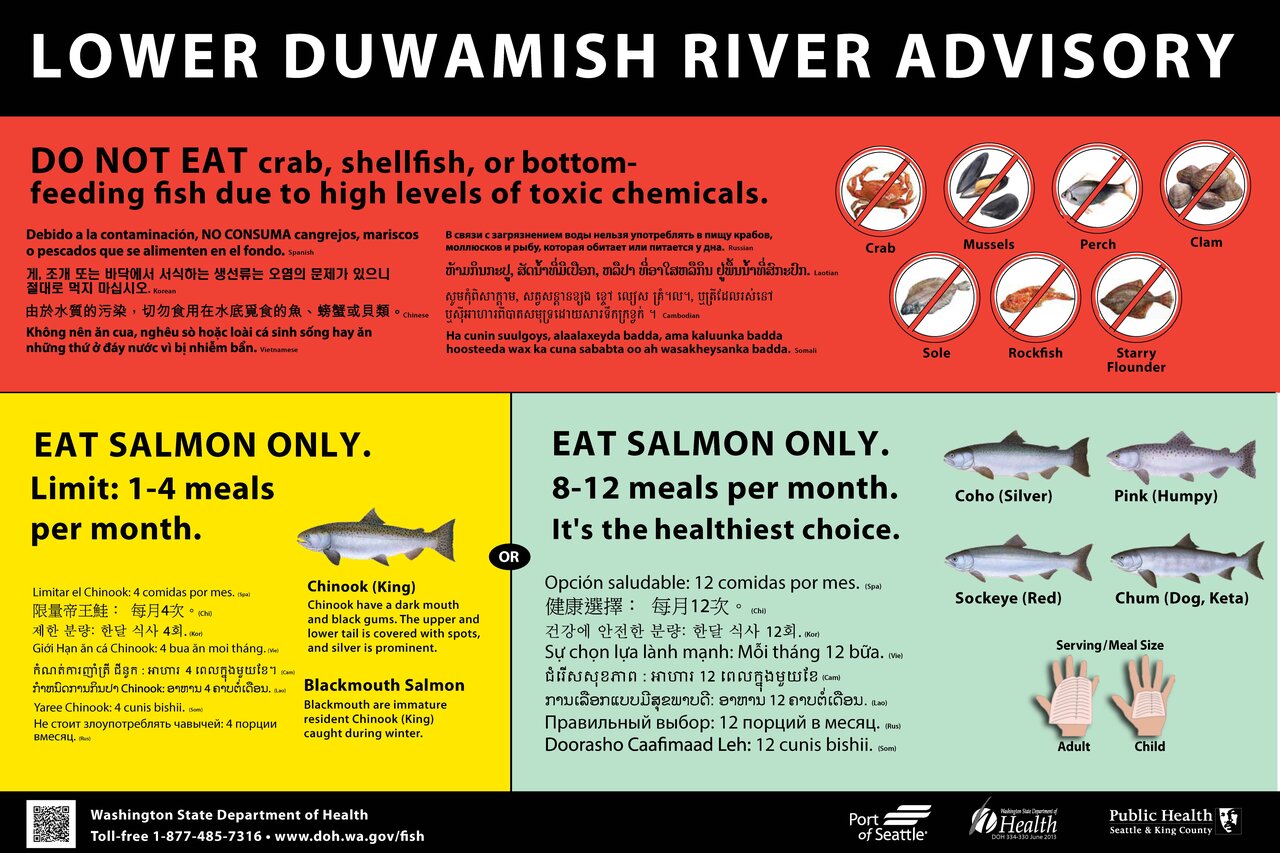Staying safe while using the river

We expect the cleanup to reduce PCB contamination in the waterway sediment by ninety percent or more. Background levels of PCBs in urban environments create challenges to further reducing contamination levels. Because of this, fishing advisories will remain in effect in the Lower Duwamish, which is consistent with other urban water bodies.
Fishing for safe seafood to eat
In the Duwamish, the greatest risks to people today come from eating flatfish, perch, crabs and clams. Lower risks are linked to direct contact with sediments (river mud) – from clamming, tribal net fishing and public breach play. There are also risks for animals such as river otters, and worms and invertebrates in the mud. Fish advisories are posted, advising no consumption of resident local fish, with exceptions (see below).
According to the Washington State Department of Health the main pathway for exposure to contaminants in the Lower Duwamish Waterway is through seafood consumption. Do not eat any crab, shellfish, or fish (the exception is salmon) from the Lower Duwamish Waterway.
Reduce your exposure to contaminants in Duwamish sediments
Although according to the Washington State Department of Health the main pathway for exposure to contaminants in the Lower Duwamish Waterway is through seafood consumption (above), soils and sediments at public access areas along the river may also contain PCBs and other toxic contaminants.
Lower your exposure at Lower Duwamish Waterway beaches
Although health risks from recreational activities on the Lower Duwamish Waterway beaches are relatively low, common sense approaches can reduce exposure to contaminants.
-
Keep clean:
- If you go to the beach, wash your hands and face with soap afterwards, especially before eating.
- Clean dirt from under your nails.
- Wash soiled clothing separately.
- Young children are especially sensitive to contaminants. Remember to wash your children's hands, toys, and pacifiers.
- Keep pets clean.
- Avoid bringing contaminants home
- Stay in public use areas
-
Swimming in the Lower Duwamish Waterway:
- You can swim in the river, but be aware there are several combined sewer overflows (also known as CSOs) that can discharge waste water into the waterway during periods of heavy rain. King County has CSOs in the LDW. The agency Public Health-Seattle & King County recommends against swimming near combined sewer overflows for a period of 48 hours (two days) after the last heavy rain in case CSO has discharged.... If you wish to know if a CSO has discharged, King County provides service to learn if a CSO has discharged.
What is the risk?
Contamination from nearly 100 years of industrial and commercial activities in the drainage basin has settled into the sediments at the bottom of the waterway. The contaminated sediments pose health risks to:
-
People who eat seafood living in the waterway (but not salmon)
-
People who come into contact with sediments along the waterway’s banks and beaches
-
Benthic organisms living in the sediments that are important to the waterway’s food chain
-
Some wildlife living in the waterway, including river otters
The Lower Duwamish Waterway Superfund cleanup is intended to reduce the risks to these four groups posed by the waterway’s sediments.

 Translate
Translate